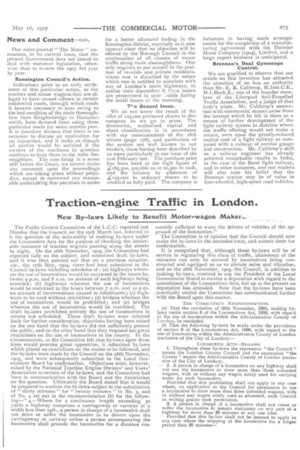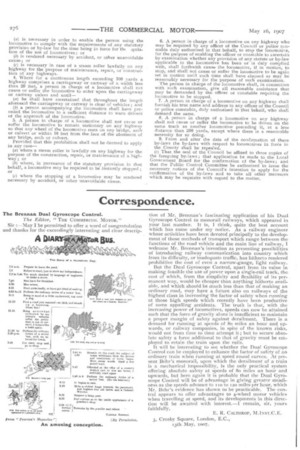Traction-engine Traffic in London.
Page 15

Page 16

If you've noticed an error in this article please click here to report it so we can fix it.
New By-laws Likely to Benefit Motor-wagon Maker.,
The Public Control Committee of the L.C.C. reported last Monday that the Council, on the 19th March last, referred to it the question of the desirability of making by-laws under the Locomotive Acts for the purpose of checking the intolerable nuisance of traction engines passing along the streets by night. On the 28th November, 19o5, the Committee had reported fully on the subject, and submitted draft by-laws, and it was then pointed out that on a previous occasion, viz., the 17th May, 1904, there had been submitted to the Council by-laws including schedules of : (a) highways whereon the use of locomotives would be restricted to the hours between 9 p.m. and 8 a.m. on account of such highways being crowded; (b) highways whereon the use of locomotives would be restricted to the hours between 7 a.m. and io p.m. on account of inconvenience caused to inhabitants ; (e) highways to be used without restriction ; (d) bridges whereon the use of locomotives would be prohibited ; and (e) bridges whereon the use of locomotives would be restricted. The draft by-laws prohibited entirely the use of locomotives in streets not scheduled. These draft by-laws were referred back for further consideration, objections having been raised on the one hand that the by-laws did not sufficiently protect the public, and on the other hand that they imposed too great restrictions on the use of locomotives in the county. In the circumstances, as the Committee felt that by-laws upon these lines would provoke great opposition, it submitted by-laws which placed no restrictions on the routes to be followed, and the by-laws were made by the Council on the 28th November, 1905, and were subsequently submitted to the Local Government Board for confirmation. Objections were, however, raised by the National Traction Engine Owners' and Users' Association to certain of the by-laws, and the Committee had been in communication with the Board and the Association on the question. Ultimately the Board stated that it would be prepared to confirm the by-laws subject to the substitution of " thirty minutes " for " twenty minutes " in No. 3, and of No. 4 set out in the recommendation (b) for the following—" 4.—Where for a continuous length exceeding 50 yards a highway comprises a carriageway or cartway of a width less than 24ft., a person in charge of a locomotive shall not .drive or suffer the locomotive to be driven upon the carriageway or cartway unless a person accompanying the locomotive shall precede the locomotive for a distance rea
sonably sufficient to warn the drivers of vehicles of the approach of the rocomotive."
The Committee is of opinion that the Council should now snake the by-laws in the amended form, and submit them for confirmation.
It is recognised that, although these by-laws will be of service in regulating this class of traffic, abatement of the nuisance can only be secured by locomotives being constructed and equipped so as to obviate noise and vibration, and on the 28th November, 1905, the Council, in addition to making by-laws, resolved to ask the President of the Local Government Board to receive a deputation with regard to the amendment of the Locomotives Acts, but up to the present no deputation has attended. Now that the by-laws have been practically settled the Committee has communicated further with the Board upon this matter.
THE COMMITTEE'S RECOMMENDATIONS.
(a) That the resolution of 28th November, 1905, making bylaws under section. 6 of the Locomotives Act, 1898, with regard to the use of locomotives within the Administrative County of London, be rescinded.
(b) That the following by-laws be made under the provisions of section 6 of the Locomotives Act, 1898, with regard to the use of locomotives within the Administrative County of London (exclusive of the City of London)— LocomonvE ACTS-BY-LAWS.
1. Throughout these by-laws the expression "the Council" means the London County Council and the expression "the County" means the Administrative County of London (exclusive of the City of London). 2. A person in charge of a locomotive on any highway shall not use the locomotive to draw more than three unloaded wagons, with or without any wagon solely used for tarrying water for such locomotive.
Provided that this prohibition shall not apply in any case where, on application to the Council for permission to use a locomotive to draw more than three unloaded wagons, with or without any wagon solely used as aforesaid, such Council in writing grants such permission.
3. A person in charge of a locomotive shall not cause or suffer the locomotive to remain stationary on any part of a highway for more than 30 minutes at any one time.
Provided that this by-Taw shall not be deemed to apply in any case where the stopping of the locomotive for a longer period than 30 minutes- (a) is necessary in order to enable the person using the locomotive to comply with the requirements of any statutory provision or by-law for the time being in force for the !.gulabon of the use of locomotives; or (b) is rendered necessary by accident, or other unavoidable cause; or (c) is necessary in case of a steam roller lawfully on any highway for the purpose of maintenance, repair, or construction of any highways.
4. Where for a continuous length exceeding 100 yards a highway comprises a carriageway or cartway of a width less than 20 feet, a person in charge of a locomotive shall not cause or suffer the locomotive to enter upon the carriageway or cartway unless and until—
(a) he shall have ascertained that throughout the length aforesaid the carriageway or cartway is clear of vehicles ; and (b) a person accompanying the locomotive shall have preceded the locomotive to a sufficient distance to warn drivers of the approach of the locomotive.
5. A person in charge of a locomotive shall not cause or suffer the locomotive to remain stationary on any highway so that any wheel of the locomotive rests on any bridge, arch or culvert or within 10 feet from the face of the abutment of any bridge, arch or culvert.
Provided that this prohibition shall not be deemed to apply in any case—
(a) where a steam roller is lawfully on any highway for the purpose of the construction, repair, or maintenance of a highway; or (b) where, in pursuance of the statutory provision in that behalf, a locomotive may be required to be instantly stopped t or (c) where the stopping of a locomotive may be rendered necessary by accident, or other unavoidable cause. 6. A person in charge of a locomotive on any highway who may be required by any officer of the Council or police constable duly authorised in that behalf, to stop the locomotive, for the purpose of enabling the officer or constable to ascertain by examination whether any provision of any statute or by-law applicable to the locomotive has been or is duly complied with, shall forthwith cause the locomotive, if in motion, to stop, and shall not cause or suffer the locomotive to be again set in motion until such time shall have elapsed as may be reasonably necessary for the purpose of such examination. The person in charge of the locomotive shall, in connection with such examination, give all reasonable assistance that may be demanded by the officer or constable requiring the locomotive to be stopped.
7. A person in charge of a locomotive on any highway shall furnish his true name and address to any officer of the Council or police constable, duly authorised in that behalf, who shall demand the same.
8. A person in charge of a locomotive on any highway shall not cause or suffer the locomotive to be driven on the same track as another locomotive preceding it, at a less distance than 200 yards, except where there is a reasonable necessity for so doing.
9. From and after the date of the confirmation of these by-laws the by-laws with respect to locomotives in force in the County shall be repealed.
(c) That the seal of the Council be affixed to three copies of the foregoing by-laws ; that application he made to the Local Government Board for the confirmation of the by-laws; and that the Public Control Committee be authorised to issue the necessary notices of the Council's intention to apply for the confirmation of the by-laws and to take all other measures which may be requisite with regard to the matter.






















